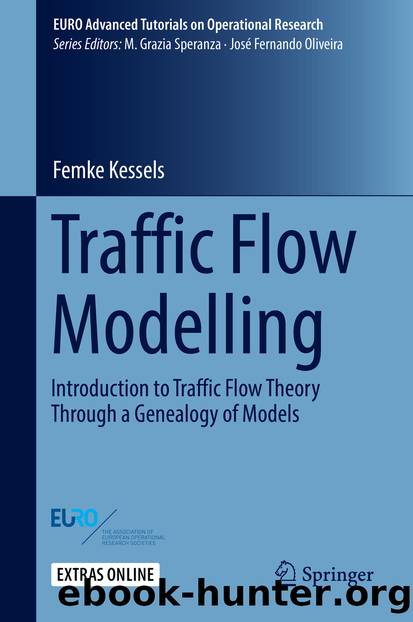Traffic Flow Modelling by Femke Kessels

Author:Femke Kessels
Language: eng
Format: epub
ISBN: 9783319786957
Publisher: Springer International Publishing
We note that the presented formulation of Fastlane includes an implicit density function (4.19): to calculate the density, the pce values need to be known, for which the densities are needed (4.20). An alternative formulation of Fastlane that is more practical to apply and more theoretically sound (because it does not have this implicit self-reference)—albeit much more complicated at first sight—is presented by van Wageningen-Kessels et al. (2014).
4.2.3 Models with Three Regimes
A different approach to modelling the behaviour of classes that share a (multi-lane) road is by assuming that the flow is always in a ‘lane distribution equilibrium’. In this equilibrium, the vehicles distribute themselves over the lanes in such a way that any other distribution would lead to lower speeds for at least one of the classes. Furthermore, all vehicles drive as fast as possible, on the fraction of the road that is available to them. The most simple of this type of models is the two-class and two-lane model by Daganzo (2002). The terminology of ‘slugs’ (slow cars) and ‘rabbits’ (fast cars) is used. Slugs always stay on the outer lane. Rabbits can use both lanes and chose among them based on a user equilibrium. This gives rise to 3 possible ‘regimes’, see also Fig. 4.10c: free flow
If there are few cars, fast cars will remain on the inner lane and drive at their maximum speed.
Download
This site does not store any files on its server. We only index and link to content provided by other sites. Please contact the content providers to delete copyright contents if any and email us, we'll remove relevant links or contents immediately.
| Automotive | Engineering |
| Transportation |
Whiskies Galore by Ian Buxton(41530)
Introduction to Aircraft Design (Cambridge Aerospace Series) by John P. Fielding(32888)
Small Unmanned Fixed-wing Aircraft Design by Andrew J. Keane Andras Sobester James P. Scanlan & András Sóbester & James P. Scanlan(32573)
Craft Beer for the Homebrewer by Michael Agnew(17933)
Turbulence by E. J. Noyes(7700)
The Complete Stick Figure Physics Tutorials by Allen Sarah(7141)
Kaplan MCAT General Chemistry Review by Kaplan(6595)
The Thirst by Nesbo Jo(6436)
Bad Blood by John Carreyrou(6275)
Modelling of Convective Heat and Mass Transfer in Rotating Flows by Igor V. Shevchuk(6223)
Learning SQL by Alan Beaulieu(6035)
Weapons of Math Destruction by Cathy O'Neil(5829)
Man-made Catastrophes and Risk Information Concealment by Dmitry Chernov & Didier Sornette(5647)
Digital Minimalism by Cal Newport;(5389)
Life 3.0: Being Human in the Age of Artificial Intelligence by Tegmark Max(5184)
iGen by Jean M. Twenge(5161)
Secrets of Antigravity Propulsion: Tesla, UFOs, and Classified Aerospace Technology by Ph.D. Paul A. Laviolette(4992)
Design of Trajectory Optimization Approach for Space Maneuver Vehicle Skip Entry Problems by Runqi Chai & Al Savvaris & Antonios Tsourdos & Senchun Chai(4840)
Electronic Devices & Circuits by Jacob Millman & Christos C. Halkias(4748)
